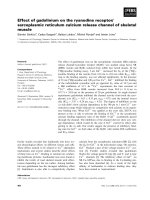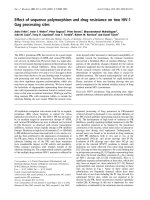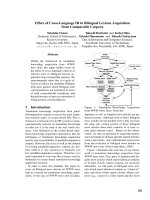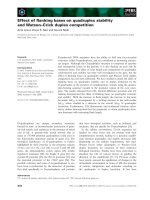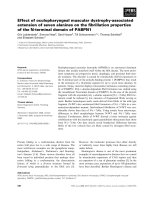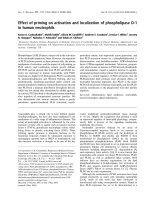Báo cáo khoa học: " Effect of Anionic Salt and Highly Fermentable Carbohydrate Supplementations on Urine pH and on Experimentally Induced Hypocalcaemia in Cows" ppsx
Bạn đang xem bản rút gọn của tài liệu. Xem và tải ngay bản đầy đủ của tài liệu tại đây (134.32 KB, 9 trang )
Mellau LSB, Jørgensen RJ, Bartlett PC, Enemark JMD, Hansen AK: Effect of an-
ionic salt and highly fermentable carbohydrate supplementations on urine pH and
on experimentally induced hypocalcaemia in cows. Acta vet. scand. 2004, 45, 139-
147. – The objective of this experiment was to determine the effect of dietary grain on
calcium homeostasis. Six rumen-fistulated dairy cows with 3 or more previous lacta-
tions and no history of parturient paresis were randomly assigned to a sequence of diets
in a crossover study with 4 periods of 10 days each. Dietary treatments were: A control
ration consisting of wrap grass silage alone (1), the control ration supplemented with
ammonium chloride and ammonium sulphate salt solution (2), control ration following
a period with supplementation (3) and control ration supplemented with increasing
amounts of barley from 4 to 10 kg/cow per day, expected to produce subclinical rumen
acidosis (4). Daily intake of the diets was adjusted to 14 kg DM/cow per day. On day 11,
the calcium-regulating mechanisms in cows were challenged until recumbency by a
standardized intravenous EDTA infusion and cows were left to recover spontaneously.
Anion supplementation and the feeding of highly fermentable carbohydrate lowered
urine pH below 7.0 due to subclinical acidosis. During spontaneous recovery from
EDTA induced hypocalcaemia, the cows more quickly regained a whole blood free cal-
cium concentration of 1.00 mmol/L if they had most recently been supplemented with
either anionic salts or with increasing amounts of barley, as compared to the basic ra-
tion. It is concluded that so-called slug-feeding or 'steaming up' with highly fermentable
carbohydrates before parturition in milk fever susceptible cows enhanced calcium
homeostasis similar to the effect seen in cows on anionic diets.
Hypocalcaemia; milk fever prevention; resistance; calcium homeostasis; calcium
binding; calcium mobilization; dairy cow; subclinical acidosis; EDTA infusion;
anionic salt; grain feeding.
Acta vet. scand. 2004, 45, 139-147.
Acta vet. scand. vol. 45 no. 3-4, 2004
Effect of Anionic Salt and Highly Fermentable
Carbohydrate Supplementations on Urine pH and on
Experimentally Induced Hypocalcaemia in Cows
By L. S. B. Mellau
1
, R. J. Jørgensen
1
, P. C. Bartlett
§
, J. M. D. Enemark
1
and A. K. Hansen
2
1
Cattle Production Medicine Research Group, Department of Large Animal Sciences, and
2
Section for Experi-
mental Animals, The Royal Veterinary and Agricultural University, Denmark,
§
College of Veterinary Medicine,
Michigan State University, East Lansing, USA.
Introduction
Successful control of milk fever incidence be-
gins with dietary management of the dry cow.
The usual prepartal dietary management of a
non-lactating dairy cow may involve concen-
trate feeding during the close-up period to
adapt the microflora and forestomach mucosa
to the high energy grain diets that will be fed af-
ter parturition (Gerloff 1988). Grain feeding
may result in subclinical rumen acidosis (SRA)
with compensated metabolic acidosis, growth
of the rumen papillae and increased production
and absorption of volatile fatty acids (VFA)
(Dirksen et al. 1984). Cattle fed cereal grain di-
ets typically are acidotic and secrete acid urine
Dr Mellau's present address: Department of Veterinary Medicine and Public
Health, Sokoine University of Agriculture P.O. Box 3021, Chuo Kikuu,
Morogoro Tanzania. Phone 255232604542, e-mail
(Owens et al. 1998). The possible effect of such
SRA derived systemic acidosis on calcium
homeostasis at calving has not been reported,
although previous investigations have focused
on grain or sugar feeding in relation to the oc-
currence of milk fever (Emery et al. 1969, Erb
& Gröhn 1988).
The aim of this investigation was to determine
whether systemic acidosis, induced by increas-
ing daily intake of highly fermentable carbohy-
drate, may have any regulating effect on cal-
cium homeostasis as monitored by an EDTA
infusion challenge to acutely bind calcium to
mimic the calcium drain produced by the mam-
mary gland at the onset of lactation. For a re-
view of EDTA-induced hypocalcaemia as a
model for spontaneous hypocalcaemia, see Jør-
gensen et al. (1999). For comparison, the wide-
ly used technique of inducing systemic acidosis
by dietary anions was also studied. The stan-
dardized intravenous Na
2
EDTA infusion test
and the judging criteria were adopted from Mel-
lau et al. (2001).
Materials and methods
Animals
The investigation was conducted with 3 Danish
Holstein and 3 Red Danish dairy cattle. All
cows were non-lactating, non-pregnant cows of
3
rd
or greater parity and with no history of milk
fever. Eight weeks before the start of the exper-
iment, 2 cows at a time were fitted with rumen
canulla to facilitate anion dosing and starch
supplementation. Cow weights were 660 ± 42
kg (mean ± SD). Each cow was kept in a sepa-
rate pen where she could eat, drink water, turn,
and lie down. Straw bedding was changed daily.
All cows were healthy and their body condition
remained stable during the study.
Dietary Treatments
Cows were assigned to 4 phases of feeding
regime of 10 days each in a crossover study de-
sign. Each of the feeding regimens was fol-
lowed by an intravenous Na
2
EDTA infusion
(see below) on day 11 to measure calcium
homeostasis. Feeding regimens were: 1. Con-
trol diet of wrap-grass silage (BR1), 2. Anion
diet, which was BR1 supplemented with am-
monium chloride and ammonium sulphate salt
solution, 3. Wrap-grass silage (BR2), to avoid
any possible carry-over effect of anion, 4. Con-
trol diet supplemented with rolled barley given
per fistula. Daily intake of the diets was ad-
justed to 14 kg dry matter (DM) /cow per day,
which was close to the expected amount that a
cow would consume ad libitum, and was kept
constant throughout the experiment. The DM
content of BR1 and BR2 was 75%. Nutrient
content of wrap grass silage was determined by
Steins Laboratory (Steins Laboratorium A/S,
DK 7500 Holstebro, Denmark) by standard
NIR method as follows: 26.2% crude protein
23.5% crude fiber and 13.2% ash, including
0.46% calcium 0.5% phosphorus 0.19% mag-
nesium 46 mg/kg zinc and 13 mg/kg copper
(DM basis).
Anion supplementation
Ammonium chloride and ammonium sulphate
was given through rumen fistula. The salts were
given at the rate of 0.23 g/kg BW per day ac-
cording to Wang and Beede (1992). The amount
of anion salts calculated per kilogram body
weight was dissolved in 1 L of tap water. At
09.00 h, 0.5 L of the solution was given after
collection of morning rumen fluid samples, and
the second 0.5 L was given at 15.00 h per fistula
during the afternoon meal.
Starch supplementation
Cows were administered 4 kg of rolled barley
per fistula in divided meals of 2 kg each on the
first day. The amount of barley was increased
gradually at the rate of 0.5 kg per day to pro-
voke metabolic acidosis, defined by urine pH,
140 L. S. B. Mellau et al.
Acta vet. scand. vol. 45 no. 3-4, 2004
until the amount given per fistula was 10 kg/day
particularly on day 10.
Blood Samples
Central venous catheters (Secalon
®
Seldy
Ohmeda, Faraday Road, Swindon, London)
were surgically inserted and fixed into both
jugular veins. Blood samples were collected via
the catheters at 09.00 h, just before offering the
morning meal, and at 18.00 h, 3 hours after af-
ternoon meal. To insert the catheters, cows
were pre-medicated by intramuscular injection
with a mixture of 2 ml butorphenol (10 mg/ml)
(Torbugesic Vet
®
, SCANVET, DK-3480) and 1
ml 1% Detomidine hydrochloride (Orion Ani-
mal Health DK-3490). Indwelling catheters
were kept patent by flushing with physiological
saline containing 0.2 ml of heparin/100 ml
saline after collection of each blood sample.
The right catheter was used for EDTA infusion
and the left for collection of blood samples.
Urine Samples
Midstream urine sample were collected by gen-
tle massaging of the perineum. Samples were
collected daily at 09.00 h before the morning
meal was offered and at 18.00 h, 3 hours after
the afternoon meal. The pH of urine and of the
rumen samples was determined cow-side using
a hand-held pH meter (Horiba Twin
®
pH-meter,
B-213, Spectrum Technologies Inc. 60544, Illi-
nois, USA). The pH-meter was calibrated each
test day before determinations using a 2-point
calibration with pH = 7.0 and 4.0. The pH-me-
ter was flushed with distilled water between
measurements. Urine pH was determined twice
on each sample and the mean figure calculated
cow-side and recorded.
Intravenous Infusion with Na
2
-EDTA
On day 11 of each dietary feeding regimen,
cows were challenged until recumbent by intra-
venous infusion with an EDTA solution. Cows
were weighed on a digital electronic scale the
day before intravenous EDTA challenging. The
infusion was prepared by dissolving 50 g of
Na
2
EDTA salt (molecular weight 372.24 g/mol.
Merck nr. 8418 pro analysi, E. Merck, D-6100
Darmstadt) in 1 L of sterile distilled water. The
intravenous infusion flow rate was adjusted to
60 mg/kg per h equivalent to 1.2 ml/kg per h
(Mellau et al. 2001) and infusion speed in
milliliter per min was fixed using an electronic
infusion pump (Masterflex
®
model No. 7523-
37, Barnant Co. Barrington, IL 60010 USA).
Whole Blood Free Calcium Monitoring
Ten milliliters of blood was collected into
sodium-heparinated test tubes (Vacutainer
®
System) at time zero (before the start of infu-
sion) and every 20 min during infusion until in-
voluntary recumbency. Before each sampling,
10 ml of blood was drawn from the catheter and
discarded. Na
2
EDTA infusion was stopped
when paresis or other clinical signs of hypocal-
caemia ensued and the cow became involuntar-
ily recumbent. During spontaneous recovery
from hypocalcaemia, hourly blood samples
were collected and analyzed for free calcium
until the concentration of 1.00 mmol/L or above
was regained. This level of 1.00 mmol/L was
chosen based on previous studies showing this
to be the lower limit for normal smooth muscle
contraction (Daniel 1983, Desmecht et al.
1995, Jørgensen et al. 1998). The period of
time in min from involuntary recumbency until
the cow had regained blood free calcium con-
centration of 1.00 mmol/L was defined as Cal-
cium Regaining Time (CRT). Whole blood free
calcium was determined cow-side using a trans-
portable acid-base analyzer (IRMA
®
Blood
Analysis System, Diametrics Medical Inc., St
Paul, MN, USA). (Since these studies were per-
formed the analyzer has been validated for use
in cattle by Hansen et al. ((2000)).
Starch and anion acidification in cows 141
Acta vet. scand. vol. 45 no. 3-4, 2004
142 L. S. B. Mellau et al.
Acta vet. scand. vol. 45 no. 3-4, 2004
Fig. 1. Average pH of urine for the 1st pair (A), 2
nd
pair (B) and 3
rd
pair (C) of cows during 4 periods of 10
days each. BR1 and BR2: Periods in which basic rations were fed with no supplements. ANIONS and STARCH:
Periods in which basic ration feeding was supplemented per fistulam with anion salts and increasing amounts of
barley, respectively. Figs. in brackets are mean values of all ten pH determinations of that particular graph. Ini-
tially (1
st
pair) urine pH determinations were not done during the BR2 period.
Statistical Analysis
The results of daily urine pH measurements
were analyzed by ANOVA. Time until involun-
tary recumbence and the CRT were analyzed
using the general linear model (SAS, 1997).
Tukey's multiple comparison test was used for
specific dietary contrasts for urine pH, and for
CRT when the difference between diets was
found to be statistically significant. The statisti-
cal model for time to involuntary recumbency
and CRT was as follows:
Y
ij
=µ+ α
i
+ß
j
+ ε
ij
;
Where:
Y
ij
= Time in min until involuntary recum-
bence or the CRT.
µ = overall mean time in min
α
i
= fixed effect for the i
th
diet
ß
j
= random effect for the j
th
cow
ε
ij
= random error variation other than that due
to the effect of the diet or cow
Results
Daily Urine pH
The trend of urine pH fluctuation during each
dietary feeding regimen and the 10 day mean ±
SEM for each pair of cows are shown in Fig. 1.
The daily urine pH differed significantly among
cow pairs (p<0.0001). Urine pH was signifi-
cantly lower during anion supplementation
compared with periods of BR1 (p<0.001), BR2
(p<0.001) or starch (p<0.05). During starch
supplementation, cows had significantly lower
urine pH compared to BR1 (p<0.001), but urine
pH did not differ significantly between periods
of starch supplementation and BR2.
Time to Involuntary Recumbence
Time (min) to involuntary recumbence due to
EDTA-induced hypocalcaemia is shown in
table 1. Significant variation (p<0.05) was ob-
served among diets. Cows on BR1 went recum-
bent faster (p<0.01) than cows supplemented
with anion salts and similarly faster than starch
supplemented cows (p<0.05). Time to involun-
tary recumbence was not statistically signifi-
cant between BR1 and BR2 cows. Comparison
of time to involuntary recumbence among indi-
vidual cows was not significant.
Calcium Regaining Time (CRT)
The CRT (Table 2) differed significantly be-
tween diets (p<0.01) as well as among cows
Starch and anion acidification in cows 143
Acta vet. scand. vol. 45 no. 3-4, 2004
Table 1. Time (min) spent by cows before involun-
tary recumbency due to EDTA-induced hypo-
calcaemia. Cows were administered one of 4 experi-
mental diets for 10 days each prior to EDTA
challenge to their calcium homeostatic mechanism.
The time until involuntary recumbence was recorded.
Cow number BR1 Anion BR2 Starch
1 200 220 160 135
2 180 140 140 120
3 195 140 130 130
4 100 120 100 80
5 90 100 90 90
6 155 115 115 130
Table 2. Calcium Regaining Time (CRT) in min in
cows administered one of 4 experimental diets. Each
diet was given for 10 days, and the calcium homeo-
static mechanism for each cow was challenged by a
standardized intravenous 5% Na
2
EDTA infusion on
day 11. Intravenous infusion was continued steadily
until the cow went involuntarily recumbent. Whole
blood free calcium was monitored cow side during
spontaneous recovery from the induced hypocal-
caemia. The first blood sample was collected at re-
cumbence. Subsequent blood samples were collected
hourly until a whole blood free calcium concentra-
tion above 1.00 mmol/l was regained. CRT at 1.00
mmol/l was then extrapolated graphically from plots.
Cow number BR1 Anion BR2 Starch
1 360 180 360 240
2 300 120 300 180
3 540 120 310 360
4 380 130 240 240
5 240 240 240 120
6 420 300 240 240
(p<0.001). The mean ± SEM CRT of 373 ± 42
min was observed in BR1 cows, 282±20 min in
BR2 cows, 230±33 min in starch supplemented
cows and 182± 30 min in anion supplemented
cows. There was a significant difference in CRT
between BR1 and anion supplemented cows
(p<0.01), and between BR1 and starch supple-
mented cows ((p<0.05).
Discussion
In this study, calcium regulation was chal-
lenged by a standardized intravenous EDTA in-
fusion until involuntary recumbence (Mellau et
al. 2001). The resistance to hypocalcaemia was
measured by the dose (minutes of EDTA ad-
ministration) needed to induce recumbency,
and by CRT. By the first criteria, the ability of
the cows to resist hypocalcaemia varied signifi-
cantly among diets. Starch supplemented cows
resisted induced hypocalcaemia better than ei-
ther BR1 or BR2 fed cows (p<0.01) although
anion supplemented cows resisted significantly
longer than others. Variation among cows in the
same context was not significant, indicating
that we were successful in maintaining repeat-
able experimental conditions during each pair
of cows. Lack of variation among cows in time
to involuntary recumbency entails an equal
chance for each individual cow to develop
hypocalcaemia manifested by paresis and re-
cumbence as long as the EDTA infusion vol-
ume and flow rate was maintained to chelate
calcium.
Specific comparisons for the effect of diets on
time to involuntary recumbency indicated that
cows on BR1 became recumbent faster than
cows supplemented with either anions or
starch. The reduced CRT in cows supplemented
with either anions or starch, compared to cows
offered BR1 or BR2, indicated enhanced cal-
cium regulation mechanisms following EDTA-
induced hypocalcaemia. Urine pH in these
cows supplemented with either anions or starch
was also observed to be less than 7.0, indicating
a mild systemic acidosis.
Acidosis has been shown to improve calcium
homeostasis in cows (Jorgensen 1974, Block
1984). The positive aspect of acidosis is not
fully understood, but at least part of it lies in its
effect on the conversion of vitamin D to its ac-
tive hormonal metabolite 1,25(OH)
2
D
3
, a key
component stimulating intestinal absorption of
dietary calcium, bone resorption and renal cal-
cium reabsorption (Lunn & McGuirck 1990).
The resulting metabolic acidosis improves cal-
cium homeostatic mechanisms by enhancing
the effect of PTH and 1,25(OH)
2
D
3
on bone, in-
testinal absorption and renal regulation of cal-
cium (Goff & Horst 1997). These responses fol-
low a negative calcium balance caused by
increased urinary excretion of calcium during
metabolic acidification (Wang & Beede 1992).
In accordance to this, plasma hydroxyproline
and other indicators of bone resorption have
also been reported to increase in cows fed aci-
dogenic diets (Block 1984). In our study, the
possible carry-over effects resulted from previ-
ous acidogenic salt supplementation. Perhaps
the invasive effect of EDTA infusion itself
could describe the relative similarity of the de-
gree of acidosis, as reflected by low urine pH,
between cattle on starch or BR2. The response
seen to anionic salt supplementation concurred
with a report involving supplementation of
cows with NH
4
Cl and (NH
4
)
2
SO
4
(Wang &
Beede 1992). The ability for improved CRT of
starch-supplemented cows most likely resulted
from increased production of VFA and lactic
acid in the rumen as a result of starch fermenta-
tion. Wadhwa & Care (1999) suggested that
short chain fatty acids (SCFA) stimulate cal-
cium absorption across the reticulo-rumen
in sheep by providing hydrogen ions to stimu-
late Ca
2+
/2H
+
exchange. Although the dietary
cation-anion difference of the experimental di-
ets was not determined during the study, going
144 L. S. B. Mellau et al.
Acta vet. scand. vol. 45 no. 3-4, 2004
from 14 kg grass silage to 4 kg grass silage plus
10 kg rolled barley is very likely to change the
dietary cation-anion difference (DCAD) inde-
pendent of organic acid load. Noteworthy here
is that adding grain in the daily ration dilutes
the effect of potassium, thereby changing the
DCAD of the ration. Rumen acidosis may lead
to systemic acidosis if the amount of organic
acids absorbed into blood exceeds the removal
of these acids from the circulation by the liver
and the kidney.
Previous experiences with a possible link be-
tween grain feeding and calcium availability
were inconclusive. Hibbs & Conrad (1966) an-
alyzed large data sets involving lactating cows
and found that the availability and absorption
rate of calcium and phosphorous were
markedly improved by the addition of 1.4-2.3
kg of grain concentrates per day. They were un-
able to explain this effect, but in their later
study Conrad & Hibbs (1973) observed a 55%
increase in absorbability of calcium in cows re-
ceiving 9 kg of concentrates/day compared to
38% in cows fed alfalfa hay. In contrast, Jones
& Luthman (1978) supplemented concentrates
containing 82% starch and 18% crude protein
with silage to sheep but gastrointestinal absorp-
tion of labeled calcium remained the same. Ac-
cording to Braithwaite (1976) the effect of sug-
ars and of grain in promoting calcium
absorption might be due to a decreased intesti-
nal pH resulting from the products of their di-
gestion. Favus (1992) observed that plasma
ionized calcium concentration increased during
compensated metabolic acidosis due to compe-
tition of Ca
++
with H
+
to the negatively charged
binding sites on the protein molecules.
Kendall et al. (1966) increased the rate of con-
centrate mixture to 1% of body weight daily for
a period of approximately 3 wk prior to calving
in 11 cows. All cows had had milk fever during
the previous lactation. Interestingly, they ob-
served that none of the treated cows developed
milk fever and the lowest blood calcium was
1.83 mmol/L, as compared to 1.37 mmol/L dur-
ing the previous calving.
In contrast to this, in an ecological analysis of
risk factors for postpartum disorders, Correa et
al. (1990) recorded an increased likelihood of
milk fever and left displaced abomasum on
farms in which the stated policy was 'to lead
feed'. They suggested that acidosis from grain
feeding may also cause hypocalcaemia, al-
though this conflicts with the findings of
Bushinsky et al. (1985) who found that acidosis
increased bone calcium availability by releas-
ing calcium from amorphous CaPO
4
and
CaCO
3
in the bone matrix.
In the present study, anion and rolled barley
supplementation lowered urine pH to below
7.0. According to Emmanuele & Staples (1994),
supplementation of readily fermentable carbo-
hydrates may increase stomach absorption of
calcium and magnesium because of more acidic
conditions resulting in greater movement of
these minerals to the lower digestive tract. They
suggested a greater release of minerals from
foodstuffs or a reduced absorption through the
rumen wall under acidic rumen conditions to be
responsible for their observations. It was appar-
ent from our study that grain supplementation
provoked systemic acidification although at a
lower level compared to anions. Therefore, an
on-farm trial on dry-cow grain supplementation
to monitor the ability to resist parturient
hypocalcaemia should be conducted.
Concluding from our findings, anions supple-
mentation or an increasing daily dose of highly
fermentable carbohydrate had a measurable and
significant effect on calcium mobilization.
Acknowledgements
This study was supported by the Danish Research
Center for the Management of Animal Production
and Health (CEPROS) (grant CEP 97-1), and by the
Danish International Development Agency (DA-
NIDA).
Starch and anion acidification in cows 145
Acta vet. scand. vol. 45 no. 3-4, 2004
References
Block E: Manipulating dietary anions and cations for
prepartum dairy cows to reduce incidence of milk
fever. J. Dairy Sci. 1984, 67, 2939-2948.
Braithwaite GD: Calcium and phosphorous meta-
bolism in ruminants with special reference to par-
turient paresis. J. Dairy Res. 1976, 43, 501-520.
Bushinsky DA, Riera GS, Favus MJ, Coe FL: Re-
sponse of serum 1,25 (OH)
2
D
3
to variation of
ionized calcium during metabolic acidosis. Am.
J. Physiol. 1985 , 249, F361-5.
Conrad HR, Hibbs JW: Changes in absorbability of
calcium and phosphorus associated with dietary
ingredients J. Dairy Sci. 1973, 56, 646. (Abstr.).
Correa MT, Curtis CR, Erb HN, Scarlett JM, Smith
RD: An ecological analysis of risk factors for
postpartum disorders of Holstein-Friesian cows
from thirty-two New York Farms. J. Dairy Sci.
1990, 73, 1515-1524.
Daniel RCV. Motility of the rumen and abomasum
during hypocalcaemia. Can. J. Comp. Med. 1983,
47, 276-280.
Desmecht DJ-M, Ainden AS, Godeau J-M, Lekeux
PM: Experimental production of hypocalcaemia
by EDTA infusion in calves: a critical appraisal
assessed from the profile of blood chemicals and
enzymes. Comp. Biochem. Physiol. 1995, 110A,
115-130.
Dirksen G, Liebich HG, Brosi G, Hagemeister H,
Mayer E: Morphologie der Pansenschleitmhaut
und Fettsäureresorption beim Rind - Bedeutende
Faktoren für Gesundheit und Leistung. Zbl. Vet.
Med. A 1984, 31, 414-430.
Emery RS, Hafs HD, Armstrong D, Snyder WW:
Prepartum grain feeding effects on milk produc-
tion, mammary edema and incidences of dis-
eases. J. Dairy Sci. 1969, 52, 345-351.
Emmanuele SM, Staples CR: Influence of pH and
rapidly fermentable carbohydrates on mineral re-
lease in and flow from the rumen. J. Dairy. Sci.
1994, 77, 2382-2392.
Erb HN, Gröhn YT: Health problems in the peripar-
turient cow. Epidemiology of metabolic disorders
in the periparturient dairy cow. J. Dairy Sci. 1988,
71, 557-2571.
Favus MJ: Intestinal absorption of calcium magne-
sium and phosphorus. In: Disorders of bone and
mineral metabolism. Edited by F.L. Coe and M.J.
Favus. 1992. pp 57-81. Raven Press, New York.
Gerloff JB: Metabolic diseases of ruminant livestock:
Feeding the dry cow to avoid metabolic disease.
Vet. Clin. North Am. Food Anim. Pract. 1988, 4,
379-390.
Goff JP, Horst RL: Physiological changes in parturi-
tion and their relationship to metabolic disorders.
J. Dairy Sci. 1997, 80, 1260-1268.
Hansen SS, Jensen AL, Jørgensen RJ: Evaluation of
a transportable [Ca
++
] and pH analyzer and of the
impact of different anticoagulants and sampling
sites in cattle. J. Vet. Med. A 2000, 47, 541-551.
Hibbs JW, Conrad HR: Calcium, Phosphorus and Vi-
tamin D. J. Dairy Sci. 1966, 49, 243-246.
Jones B, Luthman J: Feeding induced hypocalcaemia
studies on the uptake of
47
Ca from gastrointesti-
nal tract of sheep. Acta vet. scand 1978, 19, 204-
214.
Jorgensen NA: Combating milk fever. J. Dairy Sci.
1974, 57, 933-944.
Jørgensen RJ, Nyengaard NR, Hara S, Enemark JD,
Andersen PH: Rumen motility during induced
hyper- and hypocalcaemia. Acta Vet. Scand.
1998, 39, 331-338.
Jørgensen RJ, Nyengaard NR, Daniel RCW, Mellau
LSB, Enemark JMD: Induced-hypocalcaemia by
Na
2
EDTA infusion. A review. J. Vet. Med. 1999,
46, 389-407.
Kendall KA, Harshbarger KE, Hays R L, Ormiston
EE: Preventing parturient paresis in the paretic
suspect through grain feeding. J. Dairy Sci. 1966,
49, 720 (Abstr.).
Lunn DP, McGuirck SM: Renal regulation of elec-
trolyte and acid base balance in ruminants. Vet.
Clin. North. Am. Food Animal Pract. 1990, 6, 1-
28.
Mellau LSB, Jørgensen RJ, Enemark JMD: Plasma
Calcium, Inorganic Phosphate and Magnesium
during Hypocalcemia induced by a Standardized
EDTA infusion in cows. Acta vet. scand. 2001,
42, 251-260.
Owens FN, Secrist DS, Hill WJ, Gill DR: Acidosis in
cattle: A review. J. Anim. Sci. 1998, 76, 275-286.
SAS
®
User's Guide: Statistics Version 6.12 Edition.
1997. SAS Inst., Inc., Cary, NC.
Wadhwa DR, Care AD: Effect of short chain fatty
acids (SCFA) on the rates of absorption of cal-
cium, magnesium and phosphate ions from retic-
ulorumen of sheep. Proceedings. 10th Interna-
tional Conference on Production Diseases in
Farm Animals, Utrecht, Netherlands, August, 23-
28 1998, p 35 (Abstr.).
Wang, C, Beede, DK: Effects of magnesium on acid
base status and calcium metabolism of dairy
cows fed acidogenic salts. J. Dairy Sci. 1992, 75,
829-836.
146 L. S. B. Mellau et al.
Acta vet. scand. vol. 45 no. 3-4, 2004
Sammendrag
Effekt af supplerende indgivelse af anionsalte og let-
fordøjelige kulhydrater på urinens pH og på eksperi-
mentelt induceret hypocalcæmi på køer.
Formålet med dette forsøg var at undersøge effekten
af hurtig optrapning med korntilskud på calcium-
homeostasen. Seks vomfistulerede malkekøer, der
havde gennemgået mindst 3 laktationer og ikke tidli-
gere havde haft mælkefeber, blev tilfældigt fordelt i
behandlingsgrupper i et såkaldt crossover-studium
bestående af 4 perioder, hver af 10 dages varighed.
Behandlingerne bestod i følgende: En basisration be-
stående udelukkende af wrapensileret græs (1), ba-
sisration suppleret med ammoniumklorid og ammo-
niumsulfat (2), en anden basalration (3), og endelig
en basalration tilsat byg i stigende mængder (fra 4 til
10 kg/d) med henblik på at provokere en subklinisk
acidose (4). Anionsalte og byg blev givet via vom-
fistlerne. Dagligt indtag var justeret til 14 kg tørstof
per dag. Vom- og urin-pH blev bestemt daglig såle-
des: Før morgenfodringen (kl. 9) og 3 timer efter ef-
termiddagsfodringen (kl. 18). På dag 11 testedes de
calciumregulerende mekanismer ved en standardise-
ret intravenøs infusion med calciumbinderen EDTA,
der blev givet, indtil koen lagde sig ufrivilligt. Ani-
onsupplering såvel som hurtig stivelsesoptrapning
reducerede urin-pH til under 7, formentlig som ud-
tryk for en subklinisk acidose. Ved infusionstestning
efter perioder med aniontilsætning såvel som efter
perioder med hurtig stivelsesoptrapning sås, at
køerne restituerede sig hurtigere målt ved den tid, det
tog koen at hæve niveauet af fri calcium i blodet til
1.00 mmol/l, end efter perioder med basisration uden
tilsætninger.
Starch and anion acidification in cows 147
Acta vet. scand. vol. 45 no. 3-4, 2004
(Received May 13, 2004; accepted May 13, 2004).
Reprints may be obtained from: L. S. B. Mellau, Department of Veterinary Medicine and Public Health, Sokoine
University of Agriculture, P.O. Box 3021, Chuo Kikuu, Morogoro Tanzania. E-mail: , or



